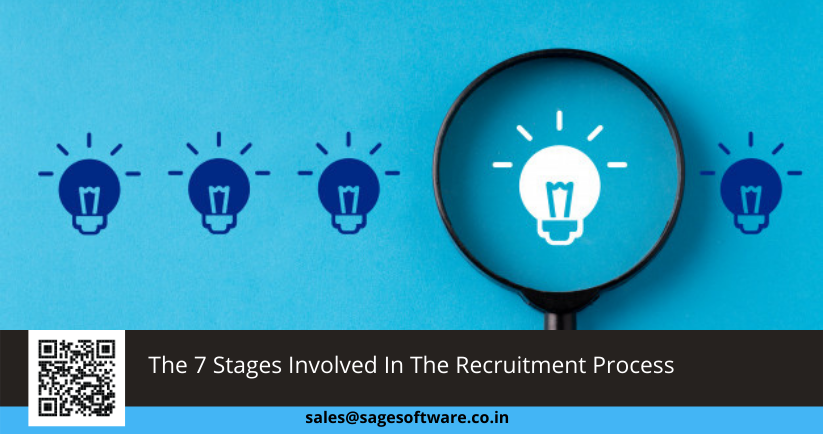A good selection process is paramount in finding the best-suited candidates that form the backbone of the company. In this article, we will take a look at the detailed steps that are involved in the selection process to find the ideal employee, simultaneously ensuring a smooth candidate experience.
The process of selection is targeted to peruse and hire the best candidate for the particular job description. This procedure is usually referred to as a funnel. For instance, 100 candidates may apply for a job role, 10 of them are shortlisted for a face-to-face interview, and only one gets recruited. The first step of the selection process is always a job opening. This vacant position should have a crystal clear of what the job role entails, such as certain skills required, educational background, and minimum years of experience.
Once the job opening is advertised, that is when the applications start rolling in and the selection process begins. The process consists of seven stages, let’s have a look at each of them in detail.
1. Application
Once the job opening has been published, interested candidates can start applying. The number of applicants depends on various factors such as the size of the company, availability of jobs, and the specific job role.
The number of candidates can vary from zero to hundreds and thousands, mainly depending on the scale of the organization, the type of business, and how successful and credible the organization is. For example, Google receives over 3 million applications per year, which means that more than 400 people apply for a particular job role.
Another key factor on which the number of applications depends the way a company advertises their job opening. In a way, a good job ad is very essential to let the candidates know the company’s work culture and credibility. For this reason, the companies should ensure that their job descriptions are bang on and representing their brand.
An ad should not only consist of the job description but also what the company will offer the candidates once they become a part of it.
2. Screening and Pre-selection
The second step perusing through the applications and shortlisting the potential candidates. This is done in multiple ways.
-
CV Screening
The most common method is a resume or CV screening. A resume contains all the details about the candidate including their educational background and years of experience. This helps the recruiters in screening and shortlisting the ones that qualify the job requirements.
If the company needs a candidate with 5 plus years experience, they will straightaway discard the resumes of fresher. Fortunately, with the evolving world, technology has evolved too, and there is various recruitment management system that can perform the screening process for the recruiters, and save their valuable time.
-
Telephonic Interview
Usually, after the screening of resumes has been done, a telephonic screening takes place of all the shortlisted candidates. The employer or the recruiter asks the candidates about their experience and expectations from the company.
They additionally ask questions based on the candidate’s resume such as what did they learn from their previous jobs or why did they leave that company, etc. Also, the employers walk the applicants through a checklist which might include points like full-time or flexible commitment, salary expectations, joining date, and other possible deal-breakers. Since this process is usually pretty standard, the companies can also use chatbots to carry out this process.
As mentioned in the above paragraph, nowadays technology has enabled us to perform these screenings automatically. One of the most popular examples of automated screening is the use of a chatbot. A chatbot asks the candidates automated questions and makes the conversation interactive.
-
Pre-selection
This is an effective screening method that filters out all the unsuitable or unqualified applicants. A good recruitment management software provides automated assessments that usually include aptitude tests, cognitive tests, or other assessments that might help in knowing which candidate is suited for the job.
Many times the CV screening is incorporated in these tools. Recruitment software also includes a detailed job preview that includes both the positive and negative sides of the job, thus giving the candidates a realistic idea about the aspects of the job they have applied for. This ensures that the thoughts of the employer and the employee are aligned and thus results in better recruitment.
This software is usually used by companies that have a high number of applicants rolling in for every job vacancy. Handling the recruitment manually becomes tedious in such cases and there is a high chance of error. These tests are usually designed for 15-20 minutes as you don’t want applicants to give a 4-hour test only to find out that they are unsuitable for the job.
3. Interview
The third step in the recruitment process is the most visible and the best-known- the interview. The interview consists of the short-listed candidates being interviewed by the recruiter or the manager to find out how suitable they are for that particular job role. The interview helps the recruiter in getting an insight into the candidate’s sociability and verbal fluency.
Additionally, the recruiter can also ask personal questions to the candidates that are concerned with the job role to ensure that the candidate is completely onboard. There are two types of interviews- structured and unstructured. In a structured meeting, a systematized set of questions are questions are asked. This helps the interviewer to follow a standardized method of recording data and rating the candidate’s qualifications.
Studies have shown that a structured interview is twice as reliable as an unstructured interview. The structured interview allows the recruiter to precisely compare the data of candidates and make take an informed decision based on their qualifications and suitability. Apart from utilizing standardized questions, another known method used is the STAR method. This process provides a methodized way to retrieve data from the potential candidates. STAR stands for-
S- Situation- Asking the candidate why they left the previous role or what situation are they currently in
T- Task- What tasks did they perform in their previous job or are looking forward to performing?
A- Action- Asking the candidates what actions they used to take to complete their task up to the expectations
R- Result- Asking the candidates what lesson they took away from their previous experiences
The STAR method is ideal to learn about the candidates’ reactions to various situations that are related to the job description. This interview method is highly recommended to assess the key competencies of the given job role.
Moreover, using this method to assess the prime competencies of the given job role is highly recommended. Needless to say, asking similar questions to every candidate applying for the job will give you an idea about their previous work experience.
4. Assessment
We briefly discussed the concept of assessments in the second stage. The stage screening or pre-selection is carried out to make a rough estimate about the least suitable candidate, assessments are used to filter out the potential best-suited candidates for the given job role.
If used perfectly, it is a highly reliable and accurate tool to select the ideal candidates. As a matter of fact, the scientific literature shows that using assessments during recruitment is as good and reliable as a structured interview.
The assessments either consist of an IQ test (also known as General Mental Ability) or testing the candidate’s traits using a five-factor assessment of personality. Higher IQ is linked with top performance and faster learning. This means that candidates with higher IQs are more productive and efficient and likely to perform better than the others.
When it comes to displaying personality, candidates who are conscientious perform way better in their job and thus are often noted as dutiful, hard-working, and ambitious. Studies show that a candidate’s level of conscientiousness influences about 10 percent of their overall performance.
Other tests comprise knowledge tests, integrity tests, and work sample tests, out of which the latter one is the most reliable. Therefore, the best way to conduct the assessment is to give the candidates a test to solve a real problem during the recruitment process.
This makes it easy to compare the results of all the interviewees, giving a plus point to make the final decision. Interviews and assessments are many times switched around. A full assessment is normally quite costly, but it is worth it as it saves a lot of time that would have otherwise gone in filtering out unsuitable candidates for the job role.
5. Background Check and References
In this stage, the long list of candidates has been filtered out and only one to three are shortlisted, and the next crucial step is doing a reference check. After having the interview with the candidates, the recruiters or the managers develop a certain perception of them in their minds, and a reference check helps the recruiters to confirm if it is true.
The candidates are asked to give a list of references from their previous jobs and the recruiters follow up on it. If during the interview the candidate brings up a certain skill that they possess and the employers are doubtful, reference checks are the ideal way to clear up these doubts. Background checks are practiced in many organizations and are now culturally determined. It can also be a requirement for the applicants to get short-listed. It helps to view the candidates’ history of good conduct or whether they had any criminal past, which is very essential, especially in teaching jobs.
6. Decision
The next stage is the biggest and most important of all- choosing the ideal candidate for the job. Many times companies give chance to a less qualified candidate, given that he/she has shown the eagerness to grow, learn, and are committed to staying in the organization for the long haul.
The decision is accurate when the selection is made on the basis of data derived from various factors such as assessments and references. In practice, this means that the candidate who has the highest relatability and qualification for the job gets selected. After the selection, the candidate is then given an offer.
7. Job Offer & Contract
After the employer has made the decision of selecting the ideal candidate, the selection process is still not over. The candidate has to accept the offer of the company to be a part of it. Usually, at this point, the employer has all the data that would make the candidate accept the offer. This conversation is usually a part of the phone interview or face-to-face interview. The offer is then made to the candidate, and only when he/she accepts it, the contract is drawn.








